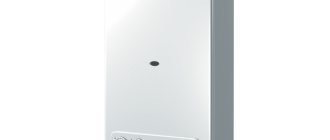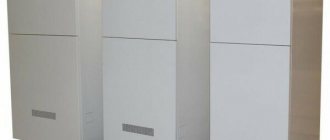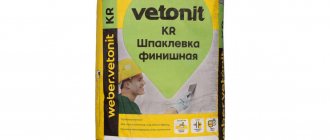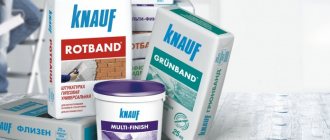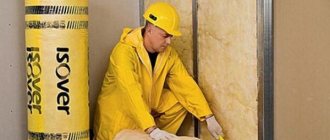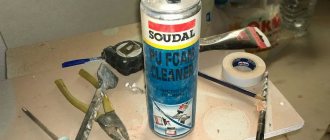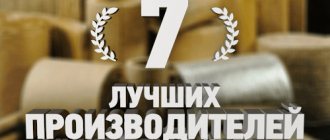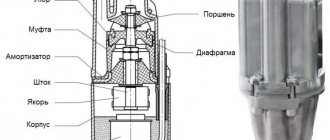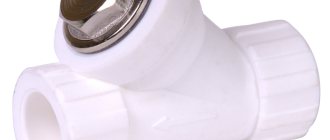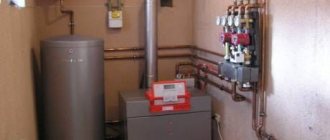In order for wallpaper, tiles or any other finishing material to look even, each wall goes through two final alignment stages, thanks to which it acquires the correct geometry. These stages are the starting and finishing putty of the walls. If the puttying process is done poorly, then after finishing it will become visible to the naked eye. Therefore, treat the final alignment process with maximum responsibility.
The finishing putty process gives the walls an unprecedented smoothness
Area of use
By leveling the surface with putty, you get bases that are resistant to negative factors and humidity, so these mixtures are quite often used for finishing bathrooms and kitchens. Using putty, you can eliminate defects in ceilings and walls, reducing the consumption of decorative materials. Among others, the finishing putty “Knauf” is presented on the building materials market, which will be discussed below.
History of the Knauf company
The Knauf company was born in 1932 in Germany. It was invented by the Knauf brothers. One brother was called Karl, and the other was Alflns. In 1949, a company was opened that was engaged in the production of gypsum putties.
Since 1993, this company began working in Russia.
The putty is manufactured according to international requirements. Each product has a certificate.
Technical characteristics of Knauf HP Finish
This gypsum putty for finishing interior work is sold in packages of 25 kg. The composition is applied to the starting layer. Its consumption is 2 kg per square meter, which is true if the layer thickness is 2 mm. Among the main properties it is worth highlighting:
- moisture resistance;
- efficiency;
- environmental friendliness;
- ability to regulate indoor humidity
If the layer thickness is 1 mm, then each square meter of surface will need 0.9 kg. After reviewing the technical characteristics of the Knauf finishing putty, you can find out that the composition contains polymer additives and gypsum. For 25 kg of dry mixture you will need approximately 13.75 liters of water. This volume can be increased to 16.25 liters.
Basic
The functions that this type performs are included in the name - processing, leveling surfaces at the initial stage to seal large holes. Apply in a thick layer of at least 2 cm. It should have good adhesion to the wall. Mandatory stage.
Knauf-Rotband Finish
Designed for plasterboard, tongue-and-groove and gypsum sheets. For interior work on top of gypsum and cement plasters. It is economically used and does not generate dust. After kneading, the working ability is maintained for 1.5 hours.
Knauf Rotband Finish
General characteristics:
| Consumption, kg/sq.m | 1 |
| Layer thickness, cm | 0,02-0,5 |
| Packing | Paper bag, dry mix, 25 kg |
| Fraction size (grain) | 0,15 |
| Shelf life | 6 months In a closed package |
Cost 364 rub.
Knauf-Fugen GV
Former name Fügen Fühler. The mixture is intended for interior use. Consists of gypsum, binders and polymer impurities. Almost all of its products are for complex use, and therefore recommends using it with gypsum fiber sheets, more precisely for filling joints and cracks.
Knauf-Fugen GV
But builders use it in other ways:
- puttying concrete and plastered surfaces with a thin layer;
- gluing plasterboard sheets to walls with a difference of up to 4 mm;
- attaching protective metal corners;
- working with gypsum elements.
It may have white, gray and pink undertones, depending on the natural impurities of the gypsum. Color has no effect on quality. The solution is mixed in a ratio of 1:0.8, in particular, 0.8 liters of cold water per 1 kg (water temperature up to 30°C), after which you need to leave the solution for 3 minutes. If you do not adhere to the temperature regime, it may crack. The addition of other substances also affects the quality. The working properties are maintained for 30 minutes before thickening begins, after which water will not bring it back to life. It is recommended to work in small portions.
General characteristics:
| Consumption | GVL joints: 0.3 – 0.6 kg per m2 with continuous puttying with a layer of 1 mm: 0.8 kg/m2 |
| Layer thickness, cm | 0,02-0,5 |
| Packing | Paper bag, dry mix, 25 and 10 kg |
| Fraction size (grain) | no more than 0.2 mm |
| Shelf life | 6 months In a closed package |
Price for 10 kg – from 200 rubles; 25kg – from 390 rub.
Knauf Multi-Finish "White"/"Grey"
Multifinish contains white and gray cement (depending on the name) and polymer admixtures. This putty is used for exterior work, decoration of facades and interior decoration of walls and ceilings. Levels concrete, cement plaster. A high-strength layer of 1-5 mm dries up to three days if the air temperature is +10°C, more than 20°C - 24 hours. The wall must be dry and clean. Mix at the rate of 0.3 liters of water per 1 kg of powder. Can be adjusted depending on the result. Plasticity is maintained for 3 hours. Not susceptible to thermal changes. If there is a risk of cracks appearing on the wall, it is necessary to use reinforced mesh. Do not sand or rub until completely dry.
Multi Finish
General characteristics:
| Consumption | continuous layer 1 mm 1.2 kg/m2 |
| Frost resistance | 25 cycles |
| Packing | Paper bag, dry mix, 25 kg |
| Shelf life | 6 months in closed packaging |
| Shelf life of the finished solution | 3 hours |
Price from 430 rub.
Knauf-Uniflot
It is recommended to mix by hand in small quantities (add water to the thick consistency as you go). In the proportion of 0.5 liters of water per kilo of powder. Used indoors for finishing slabs with perforations, seam joints, and “Superfloor” systems. The mixture is dry, based on gypsum binder with polymer additives, and does not crack. The manufacturer does not recommend thinning the hardened layer to avoid cracking of the surface.
Uniflot
Specifications:
| Consumption | continuous layer 1 mm: 0.4 kg/m2 |
| Layer thickness, cm | 0,1-0,5 |
| Packing | Paper bag, dry mix, 5 and 25 kg |
| Fraction size (grain) | no more than 0.15 mm |
| Shelf life | 6 months in closed packaging |
Price for 5 kg packaging – 365 rubles; 25 kg – 1500 rub.
Expert recommendations
The mixture can be applied in layers ranging from 1 to 3 mm. You should prepare the amount of solution that you can produce in 80 minutes. The work temperature varies from +5 to +30 °C. The composition is intended for thin puttying of ceilings and walls in residential premises, the operation of which is characterized by normal humidity. The composition must be applied manually.
Universal
This type is used in both cases. Since it combines the properties of decorative and basic, this can directly affect the quality.
Knauf-Polymer Finish
Polymer binder mixture with high adhesion. Plastic and resistant to cracking. Can be applied to coatings made of concrete, plasterboard, plaster, from floors up to 4 mm. Contains microfibers. Operable for 72 hours. You can paint or glue wallpaper after complete drying. It is used inside as a finishing thin layer, as well as a base putty. Easily removed with sandpaper. You need to work in a temperature range of 10-30°C. Putty for dry rooms.
Polymer Finish
Specifications:
| Consumption | For a continuous layer 1.2 kg/sq.m |
| Layer thickness, mm | 0-2 |
| Fraction size (grain) | no more than 25 microns |
| Complete drying time 1 mm | Day |
| Packing | Paper bag 20 kg |
| Shelf life | 12 months in a sealed container |
Price 440 rub.
Knauf-Fugen Hydro
Unlike the previous one, Fugenfüller Hydro contains hydrophobic additives. For sealing seams and installing plasterboard and gypsum fiber sheets. The putty is intended for interior work in damp rooms and does not shrink. Layer thickness from 1 to 5 mm. Mix in a proportion of 1.3 liters per 1 kg of mixture.
Fugen Hydro
General characteristics:
| Consumption | GVL joints: 0.25 kg per m2 with continuous puttying with a layer of 1 mm: 0.8 kg/m2 |
| Layer thickness, cm | 0,02-0,5 |
| Packing | Paper bag, dry mix, 25 kg |
| Fraction size (grain) | no more than 0.2 mm |
| Shelf life | 6 months In a closed package |
Cost from 890 rub.
Knauf-Fugen
Sealing of joints of thin and semicircular-edged plasterboard sheets (GKL) occurs using reinforcing tape. Covers cracks, suitable for puttying both concrete and walls prepared with plaster. Can be used as an adhesive base for plasterboard panels. Designed for interior decoration with a layer of 0.1-0.5 cm.
Fugen
General characteristics:
| Consumption | per layer 0.1 mm 1m2 sealing joints, cracks - 250 g per m2 |
| Layer thickness, cm | 0,02-0,5 |
| Packing | Paper bag, dry mix, 5, 10, 25 kg |
| Fraction size (grain) | no more than 0.2 mm |
| Shelf life | 6 months In a closed package |
Price 113, 203 and 414 rubles, depending on volume.
Instructions for use
The Knauf finishing putty, the consumption of which was mentioned above, must be prepared before application. To do this, the dry mixture is mixed with water manually or with a mixer until a homogeneous mass is obtained. After completion of work, tools and containers should be washed in clean water. The base should be prepared, for this it is cleaned of dirt, dust and loose particles. It is important to exclude the presence of formwork oils on the surface.
The area to be treated must be dry. It is important to make sure that it is solid, level and resistant to damage. Knauf finishing putty is used to fill seams and cracks. If necessary, the surface can be completely puttied. If there are irregularities and depressions on the base, they should be repaired at the initial stage of cladding. This is due to the fact that Knauf finishing putty is used to make the surface smoother.
Briefly about the product
Putty is a composition containing substances that form a film, filling irregularities, crevices and cracks. Used as a preparatory stage for interior and facade work. They come in the form of dry mixtures and ready-to-use without mixing the solution. This affects the price and shelf life. Ready ones can be frozen if the entire package is not used immediately.
The entire product line is divided according to two criteria:
- compound;
- appointment.
Based on their composition, there are gypsum, cement and polymer mixtures, each of which has its own characteristics. Thus, the gypsum composition is the cheapest, but is not “friendly” with water - it is used only in those rooms where there is not and will not be a humid environment. Cement ones are several orders of magnitude stronger, but they shrink significantly. Polymer ones perform best, but they are also more expensive.
According to their intended purpose, the market offers: basic (starting), finishing (decorative) and universal. According to the name, the first is applied to plastered walls as a preparation, the second creates a perfectly flat, smooth surface, and the third, universal, can be used to seal large flaws on any surface.
Work methodology
Using the described composition, you can form a relief pattern on the surface. The working solution is prepared in such a way that the consistency resembles thick sour cream. The composition is applied to walls that have been previously treated with Rotband Grund. To create a texture, you can use one of the methods existing today. The simplest is the “rock” texture. To do this, the plaster is applied to a small area, the area of which varies from 0.5 to 1 m2. This is done so that the 3 mm layer does not dry out prematurely.
Next, the trowel should be applied flat to the plastered area, but you should not press it too hard. The lower edge of the trowel rises, while the master should make a smooth movement directed downward. Before the final separation of the tool from the surface, it should be directed in different directions. As soon as the plaster has dried, its surface should be rubbed, which will remove the most protruding areas. This can be done using a grout mesh or a construction float. The dried surface can be painted.
Types of putty
In total, Knauf has three types of putty. Next we will consider the varieties of Rotband Knauf putty.
Characteristics of finishing putty “Knauf Rotband Pasta Profi”
For finishing walls, you can purchase Rotband paste. It is sold in 18 kg buckets, the cost of one is 757 rubles. The paste is created on a vinyl base and helps prepare walls for wallpapering or painting. The composition has excellent adhesion, is resistant to cracks and is characterized by increased whiteness.
Applying the mixture is quite simple; with its help you can smooth out walls and ceilings without putting too much effort, because the Knauf Rotband Pasta Pro finishing putty is elastic. It is manufactured in Russia, so it is more affordable in cost compared to foreign analogues. The composition is intended for dry rooms. For each square meter with a layer thickness of 1 mm it will take approximately 1.5 kg. Rotband paste is white and is intended for internal application.
Among the special properties, non-shrinkability should be highlighted. The solution remains viable for 24 hours. The layer thickness can vary from 0.1 to 2 mm. Decorative plaster can be used as a finishing coating. The surface can be sanded after 24 hours. The mixture is completely ready for use. Polymer glue acts as a binder.
Types of putties: their features, pros, cons and application
Table of contents of the article: Types of putty: varieties, their features and purpose Which putty is better: subtleties of choice for a quality result How to prepare putty for use: step-by-step instructions Putty
is an excellent way to level out minor unevenness on any surface, since modern technology makes it possible to produce such compositions for practically any materials.
They putty literally everything that needs to be leveled - metal, brick, concrete, wood and even plastics. On this site we are talking about construction, which is why we will talk about construction putties. In this article together with the site stroisovety.
org we will study the types of putties and get acquainted with their features and applications.
Types of putty for walls
Types of putties: varieties, their features and purpose
In construction and repair, three main types of putties are mainly used - cement-based mixtures, gypsum putties and so-called ready-made compounds, which are mainly used for final finishing of wall and ceiling surfaces.
- Cement-based putty.
This type of putty can be called universal - they are used with equal success both indoors and outdoors. The main advantages of this type of putty include high strength and excellent resistance to moisture - they can withstand even prolonged exposure to 100% humidity. It is for this reason that their scope of application is mainly limited to leveling external walls. If we talk about the disadvantages of cement-based putties, then we can only mention its poor workability - it is quite difficult to clean it using conventional abrasive materials. In this regard, it is used as a rough finishing material when preparing walls for the application of finishing decorative coatings such as decorative plaster, tiles and other similar materials, which, due to their rigidity, easily hide its rough structure. Cement-based putty photo - Gypsum putties.
These types of putty for walls and ceilings are used exclusively indoors - gypsum is destroyed by prolonged exposure to moisture, so it is not used outside. There are two subtypes of such mixtures for leveling surfaces - these are starting and finishing mixtures. Based on their name, it is not difficult to imagine the scope of their application. Starting putty has a rough structure and is used to level surfaces whose deviation from the plane exceeds 5 mm. As for finishing mixtures, they are used for finer leveling. As a rule, these types of putties for interior work are used in pairs - first, the walls are pre-leveled using starting mixtures, and then the resulting result is brought to standard using finishing putty. Even if we are talking about puttying drywall, it is still better to use two types of mixtures - in such a situation, the seams are sealed using the starting putty, and the rest of the surface is finished with the finishing putty. Gypsum-based putty photo - Ready-made compositions based on acrylic. These types of materials can hardly be called finishing putty - to be precise, the name super-finish or even jewelry putty is more suitable for them. It is applied to the surface in a layer of no more than 1 mm and is used in most cases for fine work - it is used to complete the final finishing of walls and ceilings prepared for painting. When applied correctly, this material produces an almost glossy surface.
Which putty is better: subtleties of choice for a quality result
In most cases, putty is sold in tightly sealed bags, and there is no way to examine their contents without looking inside.
How then? You have to trust the experience, practice of specialists and the opinions of experienced people. By and large, you can apply even the worst putty to the wall, but you understand that the result may be of poor quality.
If this happens, the mixture is replaced with a better one and the last layer is applied with a quality compound.
To be specific and answer the question of which putty is best to putty on walls, the answer will be simple, but incomprehensible to many – soft. Such compositions include the Turkish putty “Eurogypsum”, mixtures of the companies Knauf and Henkel.
If we talk about domestic products, then we can highlight the putties “Starateli”, “Volma” and “Ural building mixtures”.
The quality of these products is excellent and the most important thing is that these putties have been tested by time and by more than one generation of craftsmen.
Which putty is better
There is another way to check the quality of the putty.
In many construction stores it is sold by weight - you can purchase one-, two-, or five-kilogram packages and simply try it before making a bulk purchase.
The only “but” in this whole story is that in this way they sell mainly the cheapest mixtures, which are not popular and are simply lying around in the store.
How to prepare putty for use: step-by-step instructions
Almost all types of putty are sold in stores in the form of a dry mixture - the exception is acrylic, which is completely ready for use, and to start using it, you just need to mix it. In this regard, dry mixtures are slightly inferior to them - they require proper preparation. How to prepare dry putty mixture for application? This is done quite simply.
- Pour water into a clean bucket in the amount of 1/3 of the existing capacity. We pour cold water, since hot water speeds up the hardening process of the putty.
- Pour the dry mixture into the water. It’s difficult to talk about the required quantity - it all depends on the desired thickness of the finished putty. For example, to apply the final layer, it is better to prepare a thinner solution than to putty the walls with the first layer. In general, based on practice, enough dry mixture is poured in to form a slide 100 mm high above the water. If it is not enough, then at the first stage it can be added.
- We take a construction mixer and perform initial mixing, the purpose of which is to soak the dry mixture with water.
- Leave the composition alone for about five minutes, during which time the gypsum powder should thoroughly soak. If this is not done, lumps will form in the putty.
- After five minutes, use the same mixer to mix the composition until a homogeneous mass is obtained and again leave for a couple of minutes alone.
Then we repeat the mixing procedure. How to prepare putty
In a good way, the putty takes a long time to prepare - it is mixed in several batches. A person with experience sees its condition and knows when to start working. And without experience, you will have to rely on hours or advice from specialists who say that you need to mix in at least three passes, each of which lasts 3-5 minutes.
In conclusion, considering the issue of types of putty, I want to give a couple of small tips on its use, or rather there is only one advice, but two consequences follow from it. Firstly, you should not prepare putty in large quantities, since it thickens over time and it becomes almost impossible to putty with it.
Secondly, you should not re-dilute thickened putty, especially when it comes to applying the finishing layer - it comes in lumps and begins to thicken twice as fast.
Just throw the thickened mixture into the trash, thoroughly clean and wash the bucket and mix a new portion of the solution, but in smaller quantities.
Author of the article Alexander Kulikov
Source: https://stroisovety.org/vidy-shpaklevok/
Instructions for use
Before applying the paste, make sure that the temperature of the air, the base and the putty is within +10 °C and above. If application is carried out on plasterboard sheets, they must be firmly fixed to the supporting frame. Concrete and plaster substrates must be dry, level and free of dirt, dust and delamination. Damage or large unevenness should be leveled using Knauf Fugen mixture and wait until dry.
This Knauf finishing putty does not require preliminary priming of surfaces. Before starting work, the mixture must be mixed. If necessary, you can add a little water and mix the composition again. It is important to remember that the amount of liquid should not exceed 30 ml per 1 kg.
If the putty is excessively diluted with water, this can cause severe shrinkage and reduced adhesion. For work, use clean tools and a stainless steel container. This Knauf finishing putty is applied in a layer whose thickness does not exceed 2 mm. You can use a mechanized or manual method.
The putty is leveled with a spatula. After drying, the layer can be sanded; it is best to use P240 paper for this. You can also use finer grains. The dust is removed, and each subsequent layer is applied after the previous one has dried. Tools and containers must be washed with water after completion of work. Drying time may vary, the final value will depend on the thickness and moisture content of the layer, as well as temperature.
In order to speed up the process, heat guns should not be directed at the surface to be treated. In 24 hours, a layer whose thickness is 1.5 mm will dry at a temperature of +20 °C. Air humidity should vary within 60%.
Acrylic putty: disadvantages and advantages over gypsum putty
Every year we see more and more different new products on the building materials market. This also applies to putties.
Putty is a special paste for leveling, pre-processing and preparing various surfaces. The putty is applied to the surface using a special spatula.
After complete drying, the material hardens, and all excess is sanded off with sandpaper.
Before buying putty, you should know that they are divided into several types according to their functionality, composition and degree of readiness for use.
All putty is divided into several types, it depends on its main astringent ingredients.
Gypsum putty - this putty is made on the basis of gypsum components. Gypsum putty is easy to level and does not shrink. But you should know that gypsum putty has its drawbacks: poor moisture resistance, so it is used only in a limited area.
Acrylic putty consists of a film-forming substance and filler, crushed marble. Acrylic putty is used to level the surface for interior and exterior decoration. Advantages acrylic putty is intended for almost all types of surfaces, wood, concrete, brick.
The next type is polymer putty. This putty is considered the highest quality for puttying, but you must take into account that it costs an order of magnitude higher. It has also been established that such putty is most often counterfeited.
There is another type of putty - cement. Advantages: good moisture resistance and reasonable price. Disadvantages: prone to shrinkage.
Putty is also divided into types according to the degree of readiness for use, these are ready-made putty and dry.
Ready-made putty is convenient because it has a long shelf life. But this is not its only advantage.
Ready-made putty is very convenient to use, since you do not need to waste time preparing the paste, and you also do not need to rack your brains over the preparation technology.
The paste components are sold already diluted in the required proportions, ready for use.
But the finished putty not only has advantages, it also has some disadvantages; such putty cannot be used in thin layers, as it is prone to shrinkage. In addition, ready-made putty has a high cost.
It is recommended to prepare dry putty immediately before use. This is a special mixture that contains the necessary substances in the required proportions. This putty is packaged in bags in dry form. Advantages reasonable price, good quality material, but subject to proper use.
Preparing the pasta is not at all difficult; for this purpose, there are instructions on the package that must be followed. Otherwise, you will not get the expected result. This putty is also convenient in that it is intended for any type of work, even the most delicate.
Disadvantages: The service life of the already prepared mixture is relatively short.
What is the difference between gypsum putty and acrylic putty?
The main difference between gypsum putty and acrylic putty is that gypsum putty is not able to withstand moisture. For this reason, it cannot be used, for example, in a bathroom where the humidity level is quite high. In such rooms it will peel off in pieces and crumble. Therefore, it should only be used in dry rooms.
Acrylic putty, on the contrary, has high moisture resistance and elasticity. It is used for finishing walls when leveling, and it must be applied in a very thin layer, literally 1 mm. The surface of the walls or ceiling is thus perfectly smooth and even.
Gypsum putty can be applied in a thicker layer, but the wall will look much rougher.
Another difference between these putties is that the acrylic one is sold ready-made, while the gypsum one must be diluted independently.
The choice should still be made on acrylic putty, since it has a wider range of applications. and the quality of the surface finished with it is higher.
the system chose this answer as the best
Polymer putties: acrylic and latex
During the puttying process, different types of putties can be used. In the previous article we have already examined the main characteristics of gypsum and cement putties, now we will consider for which surfaces polymer ones are best suited.
Such material is produced and sold in ready-made form, i.e. You won’t have to mix or dilute anything anymore. This is a huge plus, since it will no longer be possible to spoil the mixture, making it less stable, for example. But, unfortunately, this advantage can be negated if the putty is stored incorrectly, then it can lose all of its beneficial properties.
It’s worth noting right away that there is also diversity among polymer putties. So, they are divided into acrylic and latex. But first things first.
Acrylics use a polymer substance such as acrylic as a base. It is a completely artificial material, so its properties are easy to change.
Positive characteristics include the fact that acrylic easily interacts with all other components of the putty, forming a uniform surface structure, and this, in turn, negates the likelihood of cracks appearing after drying.
This material is quite versatile in its scope: it can be used both on internal and external walls. In addition, it is easily applied to any type of surface, retaining all its qualities equally well.
It can be wood or concrete, plastic or drywall, etc. And applying the finished mixture is a pleasure, because acrylic is already quite plastic, and with the addition of plasticizers it becomes very easy to use.
Acrylic putty can also be divided into finishing and starting, but here the classification depends not on the size of the particles, but on what additives were used.
The main disadvantage of this material is its relatively high cost compared to other types of putties, but if you take into account the cost-effectiveness of use and ease of use, as well as versatility and durability, the price becomes completely justified.
If latex is used as a polymer base, then the putty is called latex .
Since it is essentially rubber, the finished surfaces are more resistant than acrylic ones, and the material itself is more elastic.
This type of putty is even more versatile, because it can be used on all surfaces without exception, even metal. It does not shrink and can be used at almost any temperature.
But such material costs quite a lot and is recommended for use mainly on external walls, since it has low vapor permeability and practically does not “breathe”.
Thus, polymer putties can be called the most universal. Moreover, they usually contain antiseptics, which prevents the appearance of mold and mildew.
Universal acrylic waterproof putty VGT. Practice, application experience, reviews. putty
Application practice, pros and cons, advantages and disadvantages of the universal acrylic putty VGT. Methods of use.
The most important:
Really good putty at a reasonable price. After drying, it is quite durable, easy to apply, paint, and sand.
This putty can be applied in a very thin layer. The thicker layer does not crack. You can putty in two steps. First roughly, then dry, then cover the cracks and level with a thin layer.
If stored incorrectly, the putty may dry out. But, if it is not completely dry yet, then you can add a little water to it and stir.
Strengths of the universal acrylic putty VGT
It quickly comes to a tack-free finish and is ready to be sanded.
After drying, it is waterproof, does not dissolve with water, is not washed away by water-dispersed paints, and does not absorb water. The putty surface can be painted with almost any paints and enamels, both acrylic and latex, alkyd, nitro, etc. without additional priming.
Can be applied in a very thin layer, less than a millimeter. In general, it is very convenient to apply, spread like good country butter on bread.
Virtually odorless and non-toxic.
Diluted, if necessary, with water. I also wash the tool with water until the putty hardens. If it has frozen, we clean it off mechanically.
After sanding, a smooth, even surface is formed.
Can be used to putty construction bandages.
Can fill deep cracks and cavities. Gives little shrinkage when drying.
Has sufficient strength. Temporarily filled a small pothole in the floor 3 years ago. Didn't reinforce it with anything. I still go.
It applies well as a second layer, on already puttied and sanded surfaces without intermediate priming. This is generally a rare property. In my experience, many putties apply very poorly as a second coat on sanded surfaces. For normal adhesion, intermediate priming is required, otherwise the second layer will fall off.
Works well on wood, sanded chipboard, and almost any alkyd and acrylic primers.
Great price.
Disadvantages and problems of VGT putty
Although the manufacturer claims that the putty can be used to fill cavities up to 7mm without cracking, this is not actually the case. The putty, of course, cracks and shrinks in such cavities. Puttying has to be done in two stages. First roughly, and then fill the small cracks and cavities that have arisen.
Sanding produces very fine and caustic dust. Work only in a respirator and goggles, ventilate the room.
It is quite difficult to sand and quickly clogs the skin. Fine dust and rapid wear of the skin are the other side of the coin - fine filler, which allows you to apply the putty in a very thin layer. So you have to put up with it.
Application of VGT putty
I use universal acrylic putty VGT everywhere: for leveling walls and ceilings, repairing and finishing wooden products and chipboard parts, filling cavities and cracks, filling construction tape, edging chipboard, filling recesses under screw heads.
Final grade - bold plus
You may be interested in the article: Painter's tutorial.
Types of putties for walls
The reliability and quality of subsequent repairs largely depends on how correct the choice of putty for wall finishing is. Putty is an irreplaceable material, the presence of which is mandatory during the finishing process. Types of putty for walls are primarily divided into ready-to-use and “dry”.
Then they are crushed according to the type of binder component: polymer, cement, gypsum. Finally, the putties are divided according to their intended purpose.
Ready-made putties
They are produced on the basis of dispersions or latexes and represent a mass diluted in ideal proportions.
Sold in tanks or buckets.
Advantages of ready-made putty:
- can be used immediately for work;
- the finished solution can be used for an unlimited time.
Dry putties
The most common option when leveling walls. Sold in bags or bags.
Advantages of dry putty:
- ease of preparation;
- convenient to store and transport;
- low cost;
- the ability to control the degree of viscosity of the mixture;
- storage duration regardless of temperature.
Flaws:
- the need to prepare the solution strictly according to technology using additional equipment;
- the finished composition requires quick implementation.
Depending on what binder is the basis, types of wall putties can be polymer, gypsum and cement.
Polymer putties
Advantage of polymer putty:
- highest quality putty.
Flaws:
- there is a risk of purchasing defective products;
- high price.
Gypsum putties
Advantages of gypsum putty:
- no shrinkage, making it possible to level a layer more than two 2 mm thick.
Flaw:
- It is prohibited to work in rooms with sudden changes in humidity and temperature; therefore, it cannot be used for facade finishing.
Cement putties
Advantages of cement putty:
- water resistance;
- suitable for finishing rooms with high humidity.
Flaws:
- possible formation of microcracks;
- low elasticity and long hardening;
- When dry, it shrinks and requires repeated filling.
When choosing putty, you should pay attention to the size of the filler particles: the smaller they are, the smoother and more even the putty surface will be.
There are four main groups of division of putties regarding their purpose:
- Leveling - used to level the surface. They have good adhesion to the base, uniformly filling all its defects, have high strength, and smooth out unevenness.
- Finishing – prepares the wall surface for decorative finishing.
- Specialized - designed for specific tasks.
- Universal - combine the properties of the first three types of putties and can be used on almost any substrate.
Before you buy putty, you should carefully read the instructions, which indicate its type, purpose, properties, composition and materials with which it is used.
Sources: rvm.su, www.remotvet.ru, moscowsad.ru, hw4.ru, vsyashpatlea.ru
Source: https://fotocam.net/texnologii/akrilovaya-shpaklevka-nedostatki-i-preimushhestva-pered-gipsovoj
Reviews of putty “Knauf Polymer Finish”
Before purchasing a product, it is important to read reviews about Knauf polymer finishing putty. Consumers claim that the cost of a 20 kg bag is quite affordable. You will have to pay for it from 468 rubles. The dry mixture is made on a polymer basis and is intended for application to indoor surfaces. After the words have dried, it is ready for wallpapering or painting.
Application should be done in a thin layer. The composition is used for the following types of surfaces:
- cement plaster;
- gypsum fiber;
- drywall;
- concrete.
This finishing putty for Knauf wallpaper, according to consumers, has unique properties, because after mixing the solution you can use it for 72 hours. This indicates that once you mix the mixture, you can work with it for several days. Consumers like that this allows the mixture to be worked out completely, the composition can be used economically and the residues will not dry out.
The putty has high adhesion, it is resistant to cracks, is plastic and does not stick to the spatula. Application can be carried out in a uniform thin layer. According to home craftsmen, putty is excellent for use not only by professionals, but also by beginners.
In order to achieve an ideal result, other materials from the manufacturer should be used for initial leveling. The mixture is also good because it has a small grain size, which eliminates the possibility of surface fragments falling off. The coating will not shrink. Consumers claim that the mixture can also be used as a base putty. The polymer solution is an innovative development that embodies the best qualities of modern building materials.
Operating storage standards
The warranty period is 12 months from the date of production. Store closed containers in dry, dark rooms. After opening the package, Knauf Rathband should be used within the next 24 hours. After 24 hours, the material is unsuitable for further use.
After mixing, a paste-like mixture is obtained
Observe safety precautions when working with the material. Before starting puttying, it is advisable to wear gloves and protect your respiratory system from getting the mixture. Knauf Rotband putty may cause skin irritation if it comes into contact with it. If the mixture gets into your eyes, immediately begin rinsing your eyes, and in cases of prolonged burning, consult a doctor.
It is more convenient to apply the mixture to the walls using a large and small spatula
Drying the putty
- A layer of one millimeter dries within 24 hours. And a layer of three millimeters - within three days.
- Humidity should not be more than 60 percent.
Consumer Reviews
An undoubted advantage is that during operation this plaster does not crumble at all.
- Among the disadvantages, they note that it is inconvenient to apply to walls. After adding water it turns out very liquid. It is advised to add less water than what is written in the instructions.
- After drying, some people notice that the color of the walls is not quite white.
- Consumers think it's worth the money.
This plaster can be found in almost any hardware store.
Scope of application of Vetonit putty
The use of Vetonit putty ensures an excellent appearance of the finished structures. After the solution has dried, the walls can be decorated with ceramic tiles, mosaics, and plastic.
- If there are large differences, drywall is laid, and the seams and base are sealed with putty to obtain perfectly smooth surfaces on which the appearance of defects is excluded.
- Upon completion of work, an unpleasant odor may appear in the rooms, which disappears after the mixture dries.
Vetonit TT plaster mortars are used on a base made of brick or blocks of aerated concrete or expanded clay. The mixture is not afraid of frost, resistant to mold and other fungi.
Some tips
Important! The remainder of the solution after finishing work should not be poured into the bathroom or sink.
If you use Vetonit on an adhesive basis, then you can attach the wallpaper when the solution dries well.
